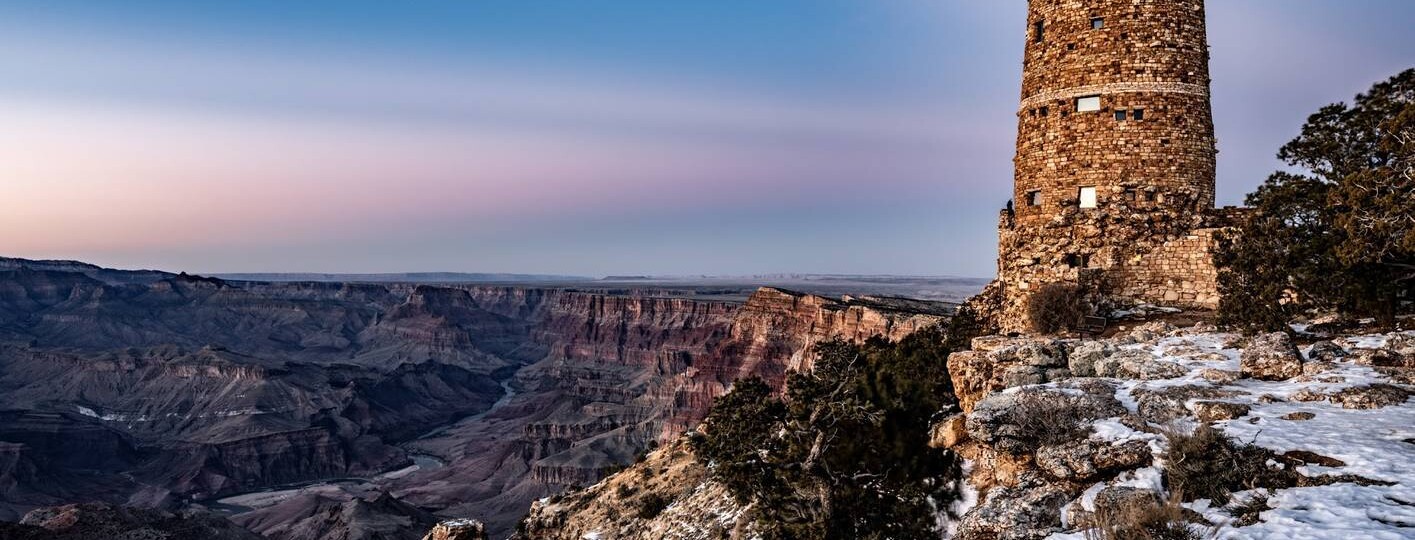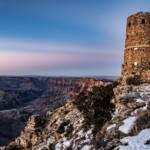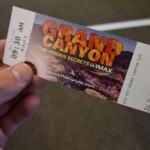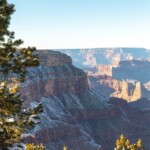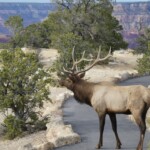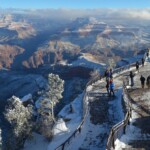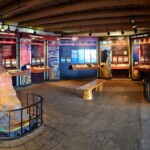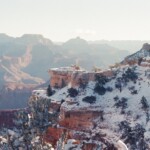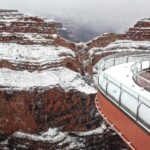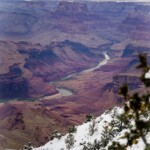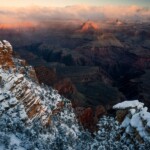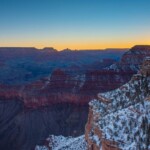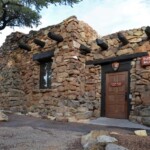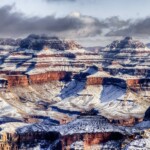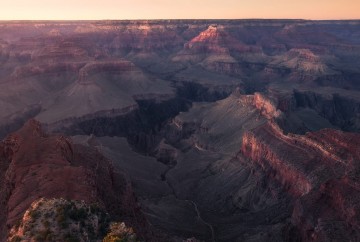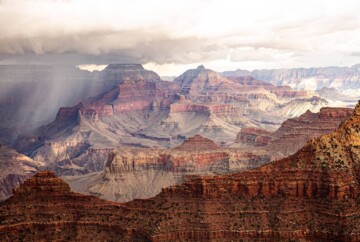Visiting the Grand Canyon in winter is a unique experience that allows you to explore a breathtaking landscape draped in tranquility and, if you’re lucky, in snowfall. In this guide, I will delve into essential tips for visiting the Grand Canyon during the winter months by offering the hidden gems and exciting activities awaiting you at the national park. It is true that winter may not be the most popular time to explore the Grand Canyon, but I can assure you that it will be a memorable journey.

Winter weather at the Grand Canyon
You can spend your Christmas at the Grand Canyon and celebrate the New Year surrounded by the special allure of the magnificent scenery. Remember that while the North Rim may be closed during this time, the South and West Rims welcome visitors with a plethora of activities, scenic vistas, and must-visit attractions. From winter hikes to awe-inspiring viewpoints, I’ll cover all the secrets of winter at the Grand Canyon in this guide. So, let’s begin!
The ultimate guide to visiting the Grand Canyon in winter
Here is a quick overview of what I’ll discuss here:
- Best things to do at the Grand Canyon in winter
- Grand Canyon winter weather
- How to get around the Grand Canyon during the winter
- Pros and cons of traveling to the Grand Canyon in winter
- Where to stay in the Grand Canyon in winter
- Grand Canyon winter outfit ideas and other things to pack
- Other tips for visiting the Grand Canyon in winter
Best things to do at the Grand Canyon in winter
There are numerous activities, viewpoints, events, and places of interest you can explore during winter at the Grand Canyon. Drawing from my personal experiences of visiting this natural wonder multiple times, I’ve compiled a list to guide your winter adventures.
1. Watch the sunrise at Mather Point and the sunset at Hopi Point
I recommend starting your adventure at Mather Point near the Grand Canyon Visitor Center, which is recognized as one of the best viewpoints in the South Rim. Trust me, catching the sunrise here is a dreamlike experience.
Unlike the bustling crowds typical of other seasons, winter at Grand Canyon National Park offers a more tranquil ambiance, making it an opportune time to explore these iconic viewpoints without the usual hustle and bustle.
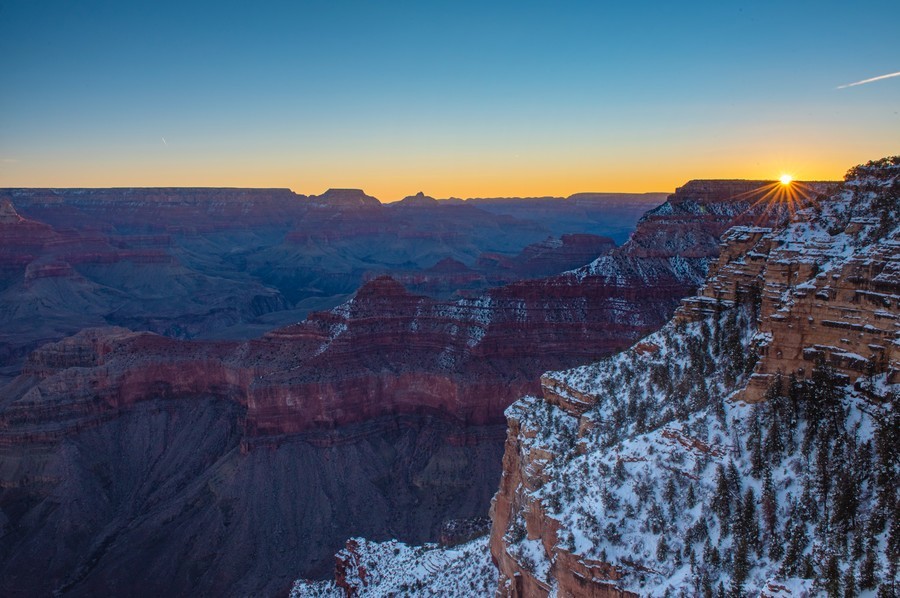
1. Watch the sunrise at Mather Point and the sunset at Hopi Point
Yaki Point, situated southeast of Mather Point, is another iconic viewpoint on the South Rim, and it offers a more secluded setting as it is closed to private vehicles and can only be reached by taking the eastbound Kaibab Rim Route shuttle buses.
Yavapai Point, west of Mather Point, features an observation station, which I’ll talk about later, and it’s on the way to Hopi Point, my favorite place to enjoy a mesmerizing sunset. If you have time, I also recommend checking Mohave Point; it’s close by and provides stunning views of the Colorado River.
2. The Rim Trail and other Grand Canyon winter hiking trails
Hiking is one of the best winter activities in the Grand Canyon, and the Rim Trail is a must-do. My personal favorite stretch is from Mather Point to Yavapai Point and further through the Trail of Time, which is the most popular section boasting captivating geological wonders.
The Rim Trail spans 13 miles, allowing you to fully appreciate the beauty of the canyon at your own pace. It’s shaded in some areas and has a modest 200-foot elevation gain, making it one of the best hiking routes in the Grand Canyon for all levels. The Rim Trail begins east of Grand Canyon Village and goes past iconic destinations like Mather Point, Yavapai Point, and Hermits Rest, offering a flexible two-hour stroll.
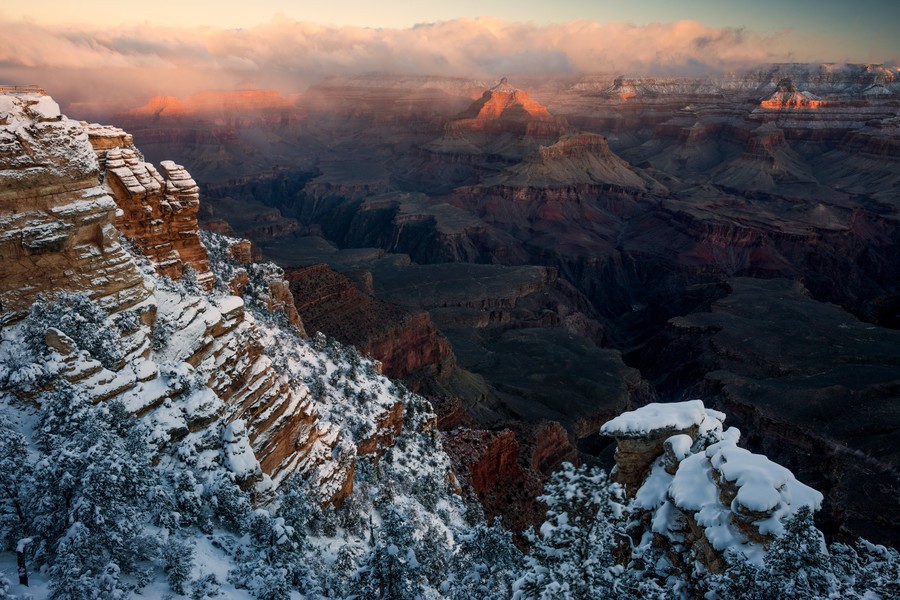
2. The Rim Trail and other Grand Canyon winter hiking trails
If you’re looking for a more adventurous activity, consider the challenging yet rewarding Bright Angel Trail, the most popular trek to the bottom of the Grand Canyon, offering a quieter winter experience without the usual crowds. While the lower sections usually remain snow-free, be careful at higher elevations where there may be packed snow and ice. For a day hike, I recommend turning around at Indian Garden (9 miles round-trip), but if you’re an experienced hiker, you can venture to Plateau Point (12 miles round-trip).
Finally, the South Kaibab Trail is another good Grand Canyon winter hike, as most of it’s bathed in sunlight. The first quarter-mile, commonly known as “The Chimney,” can be icy in winter, so be extra careful. Day hikers typically turn around at Skeleton Point, about three miles in, but with a backcountry permit, you can descend to the river and camp there.
3. Visit the Yavapai Geology Museum
Visiting the Yavapai Geology Museum, also known as the Observation Station, is one of the best things to do in the Grand Canyon in winter. Originally built in the late 1920s and undergoing a transformative renovation in 2007, the museum is a testament to the Grand Canyon’s intricate history over 17 million years.
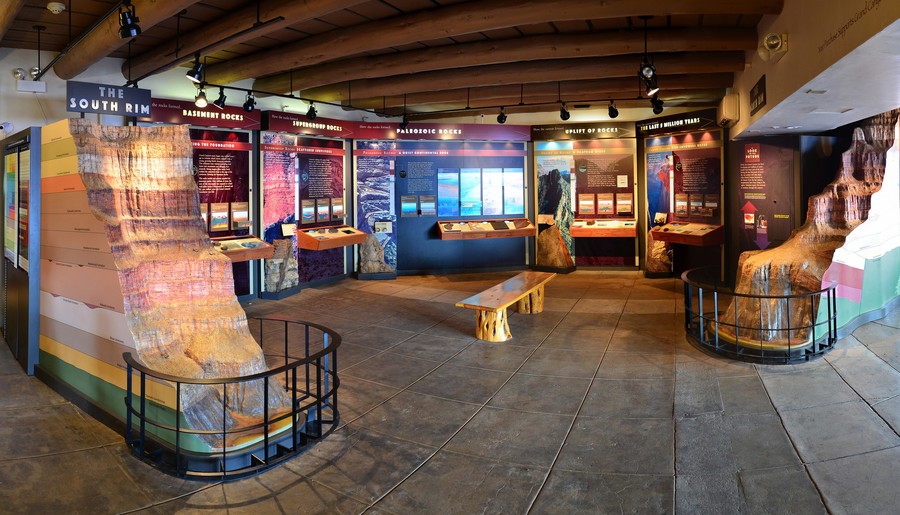
3. Visit the Yavapai Geology Museum
The museum, constructed from natural stone, is located on top of Yavapai Point, offering educational exhibits that showcase the canyon’s geological wonders. Here, you will find Native American artwork, 3D models, and informative panels about the deposition of rock layers. Exploring this site is a unique experience, combining insightful information with awe-inspiring views.
4. Enjoy Hermits Rest Scenic Drive
Hermit Road is the westernmost scenic drive on the South Rim, starting on the west side of the Village Historic District and stretching for seven miles to Hermits Rest and the Hermit Trailhead. Keep in mind that between March 1 and November 30, private vehicles are not permitted on this road, so your only option is to take the (Red) Route shuttle buses.
However, during the winter months of December, January, and February, when shuttle services are unavailable, you can take your own car and visit some of the best viewpoints in the Grand Canyon on your own, including Maricopa Point, Powell Point, Hopi Point, and Creek Overlook.
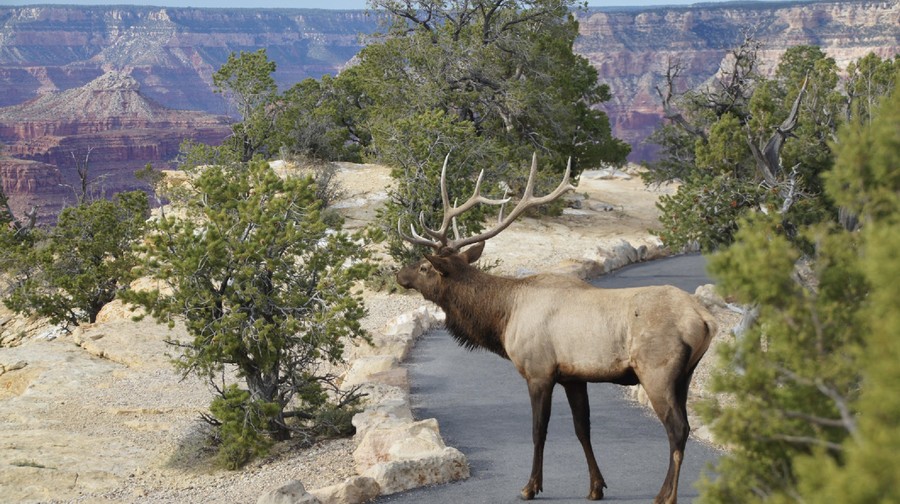
4. Enjoy Hermits Rest Scenic Drive
At the end of the road, you’ll find Hermit’s Rest, one of the most beautiful buildings designed by Mary Coulter. If you’re lucky, you can even witness elk grazing near the road —a true symbol of the incredible wildlife in the Grand Canyon.
I highly recommend making pit stops at various points along the way, as each offers its own unique views. You can also take the opportunity to experience hiking in the Grand Canyon during winter along the Hermit Trail.
5. Take a helicopter flight over the Grand Canyon in winter
Taking a helicopter tour of the Grand Canyon allows you to experience this natural wonder in a whole new light. This will be a remarkable adventure offering a unique perspective on the snow-covered landscapes of the Grand Canyon during winter.
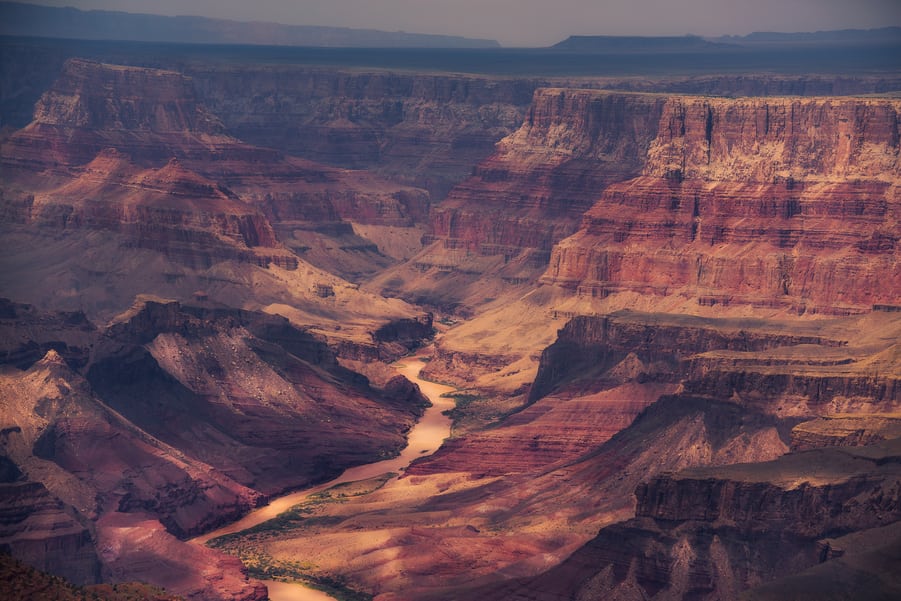
5. Take a helicopter flight over the Grand Canyon in winter
My favorite is this air tour in an EcoStar Aircraft, an environmentally friendly helicopter with panoramic windows. It’s perfect for photographers who wish to capture the snowy landscapes of Grand Canyon National Park in winter. This South Rim tour showcases the deepest and widest crevasses, providing breathtaking views of the snow-covered Grand Canyon, North Rim, East Rim, and meandering Colorado River.
Alternatively, if you’re journeying from Las Vegas, you can book this helicopter tour over the Hoover Dam, Lake Mead, and the Grand Canyon West Rim, which is one of the best Grand Canyon helicopter tours from Vegas. If you’re traveling as a couple, you can opt for the upgraded tour for a unique experience over the Las Vegas Strip at sunset, adding a touch of romance to your adventure. You will descend to a private plateau below the rim for a champagne picnic, making this an unforgettable way to witness Grand Canyon National Park in winter.
6. Watch Grand Canyon: Rivers of Time at the Grand Canyon Visitor Center
Watching Grand Canyon: Rivers of Time is one of the best things to do in the Grand Canyon South Rim. This captivating documentary is like a time machine, showing off the canyon’s history with breathtaking IMAX and time-lapse photography, with a bit of CGI thrown in. You’ll learn about the stories of early civilizations and the Spanish conquistadors’ clash with Native Americans. The film even takes you on a virtual flight over the canyon, making this one of the best activities in the Grand Canyon in winter.
This film may be short, but it’s a great way to understand the canyon’s rich history. It’s suitable for all ages, so don’t forget to book your tickets here.
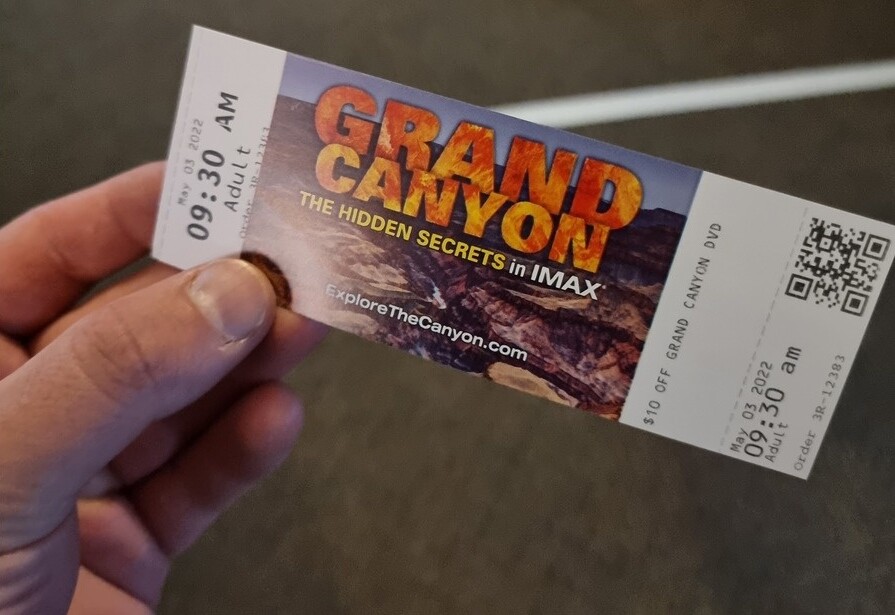
6. Watch Grand Canyon: Rivers of Time at the Grand Canyon Visitor Center
Remember, the IMAX theater is in the Tusayan Visitor Center, outside of the national park. While you’re there, don’t miss the chance to explore the adventure store. It’s a treasure trove featuring an array of books, maps, apparel, souvenirs, and gifts, which allows you to share the Grand Canyon magic with friends and family back home.
And if you go to the visitor center in Grand Canyon Village, you can watch Grand Canyon: A Journey of Wonder. This mini-documentary is the perfect orientation to the park.
7. Drive along Desert View Road to the Desert View Watch Tower
If you happen to find yourself in the Grand Canyon in winter, I highly recommend embarking on one of the best road trips in the Grand Canyon by driving along the enchanting Desert View Drive. This captivating 23-mile route, open year-round, starts from Grand Canyon Village and continues to the Desert View Services Area and the East Entrance of Grand Canyon National Park. As you drive, you will encounter six developed canyon viewpoints, four picnic areas, and five unmarked pullouts.
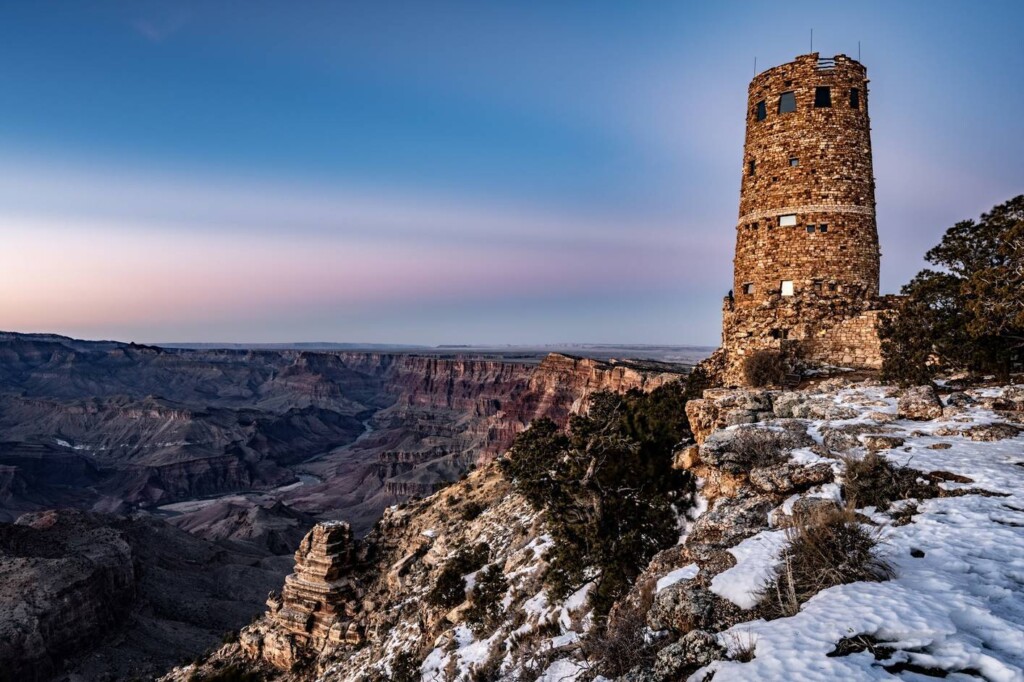
7. Drive along Desert View Road to the Desert View Watch Tower
Grandview Point offers expansive panoramic views, while Moran Point unveils visible sedimentary rocks and the ancient Grand Canyon Supergroup—a geological treasure formed 1.2 billion to 740 million years ago. Continue your exploration to Lipan Point, where Hance Rapid roars along the Colorado River. Next, you can visit the ancient Unkar Delta, a vast archaeological site showcasing the interconnected history of nature and human presence in the Grand Canyon. Your next stop is Navajo Point, the highest South Rim overlook at 7,461 feet, offering a breathtaking panorama.
Cap off your journey at Desert View Point and visit the iconic Desert View Watchtower. This masterpiece was designed in 1932 by architect Mary Colter and ingeniously blends history, culture, and striking vistas. While you’re there, make sure to visit its View Room, which is modeled after a Native American kiva, and enjoy Cultural Handicraft Demonstrations. This road trip ensures a cozy winter adventure while offering the opportunity to see the natural beauty of snowfall at the Grand Canyon.
8. Tusayan Ruins Museum
While exploring the Grand Canyon during winter, make sure to visit the Tusayan Ruins Museum, situated on Desert View Road. Just three miles west of the Desert View Watchtower, this stop is a great choice if you’re returning from your scenic drive. You’ll have the opportunity to view 2,000 to 4,000-year-old cultural items and traditional handicrafts created by the Grand Canyon’s tribal communities. This allows you to delve deep into the rich history of the people who once called this place home.
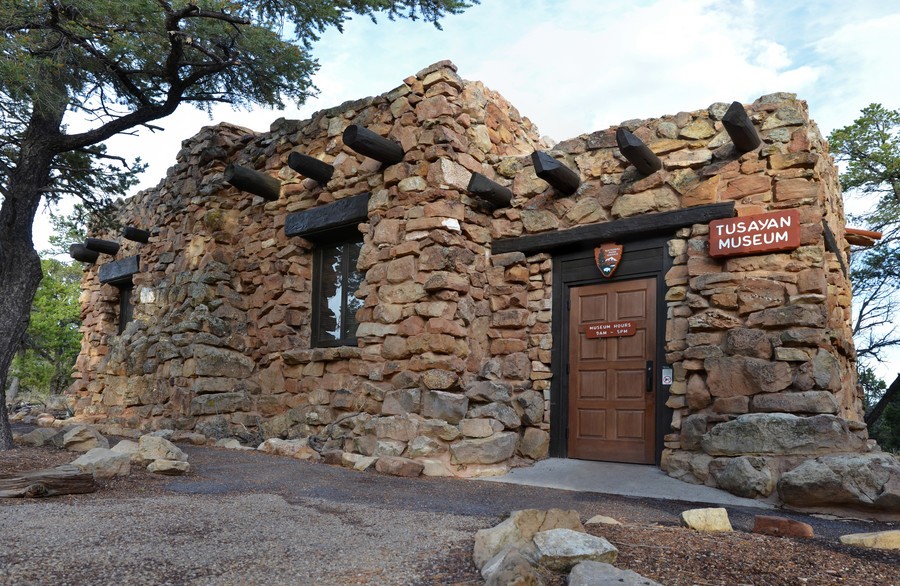
8. Tusayan Ruins Museum
You’ll have a chance to explore the remnants of a thriving community, from rooms and kivas (spaces used for rites and political meetings) to pottery, arrowheads, and other household items, all holding cultural significance for Indigenous people. The site also features a Sipapu, a small hole in the floor of a kiva. Many Hopi clans believe that this Sipapu is the portal through which the “First Peoples” of the Earth first emerged to enter the present world. Trust me, visiting this special place is one of the best things to do at the Grand Canyon in winter.
Just keep in mind that the museum may not always be open to the public, so be sure to check their website before planning your visit.
9. Ride the Polar Express
The best way to explore the Grand Canyon during winter is by hopping aboard the Grand Canyon Railway and immersing yourself in the enchanting Polar Express experience, inspired by the classic children’s book and animated film. As you enjoy your ride on the Grand Canyon Railway, take in the festive decorations and delightful seasonal atmosphere. You can relish tons of onboard entertainment options, savor hot cocoa, and indulge in sweet treats.
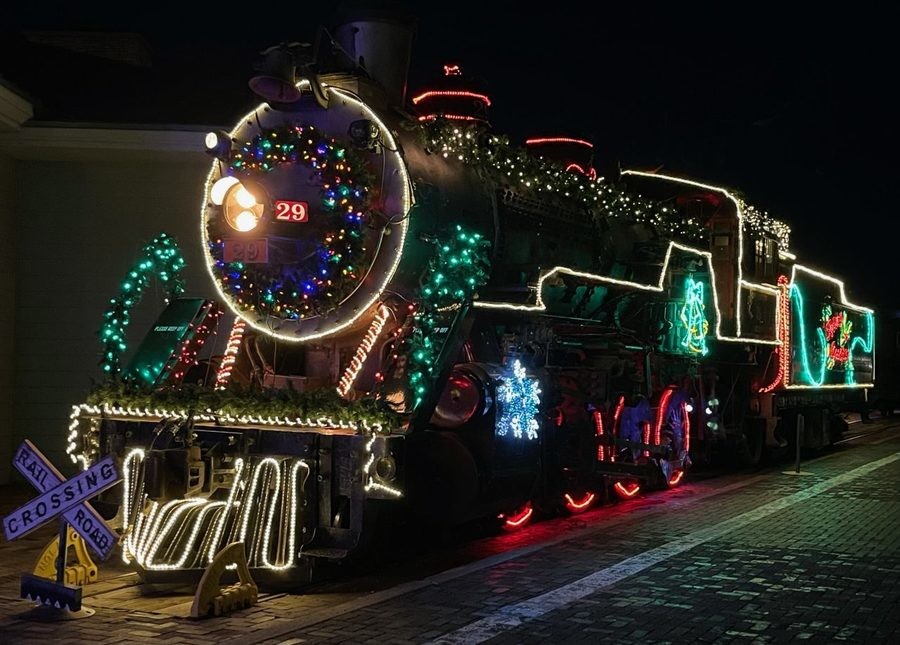
9. Ride the Polar Express
The highlight of the Grand Canyon Polar Express is a visit to a whimsical destination resembling the North Pole. Here, Santa Claus and his helpers welcome you with jolly celebrations. This immersive event adds a heartwarming touch to your holiday season, making it an ideal choice for families with children.
10. Visit the Skywalk at Grand Canyon West Rim (open year-round)
If you’re looking for an epic finale to your Grand Canyon winter adventure, I suggest visiting the Grand Canyon Skywalk at the West Rim. The Skywalk is a glass bridge extending over the canyon, providing an awe-inspiring view of the depths below. Imagine walking on air with the canyon floor visible beneath your feet – it’s pretty amazing!
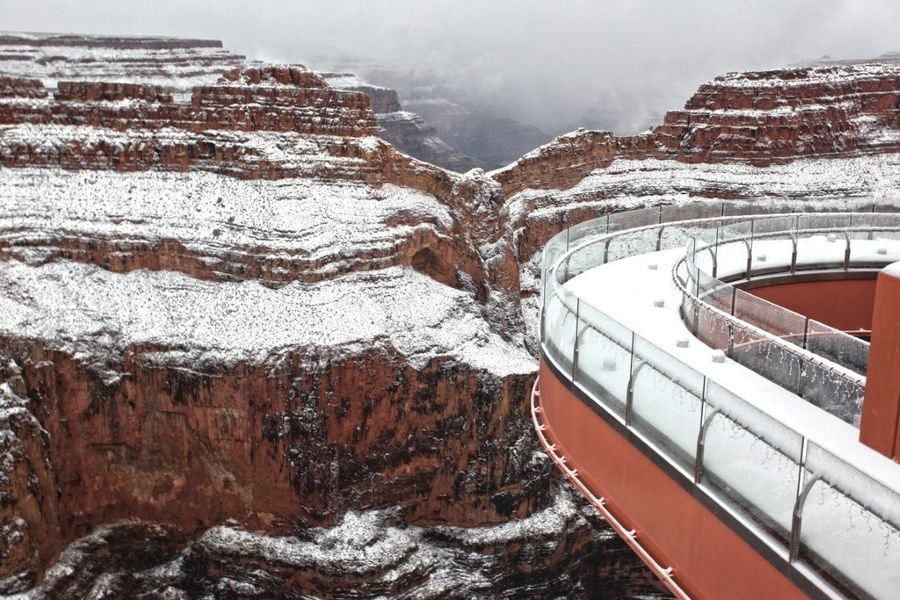
10. Visit the Skywalk at Grand Canyon West Rim
You can also engage in various winter activities at the Grand Canyon West Rim, where the chill in the air adds to the experience. I highly recommend taking a leisurely scenic walk along the rim and capturing the snow-covered vistas in stunning photographs. Winter is also an excellent time to explore the West Rim of the Grand Canyon, observe the incredible wildlife, and enjoy birdwatching. As the day transitions to night, stay for stargazing under the clear winter skies.
Remember that during the colder months (mid-October to mid-April), the Skywalk is open from 8:00 a.m. to 4:30 p.m. So, plan your itinerary accordingly.
Grand Canyon winter weather
Winter in the Grand Canyon offers a diverse weather experience across its rims. In the South Rim, temperatures range from mild to chilly, with occasional snowfall adding a picturesque layer to the landscape. The West Rim shares a similar climate, while the North Rim, at a higher elevation, experiences colder temperatures and heavier snowfall. So, determining the best time to visit the Grand Canyon depends on your preference for weather conditions and the type of experience you seek.
Average snowfall accumulation in the Grand Canyon during winter
During winter, there are varying levels of snowfall at the Grand Canyon. The South Rim typically accumulates around 60 inches of snow, transforming the canyon into a winter wonderland. The West Rim experiences a similar amount of snow. However, at the higher elevation of the North Rim, snowfall is more substantial, averaging around 140 inches.
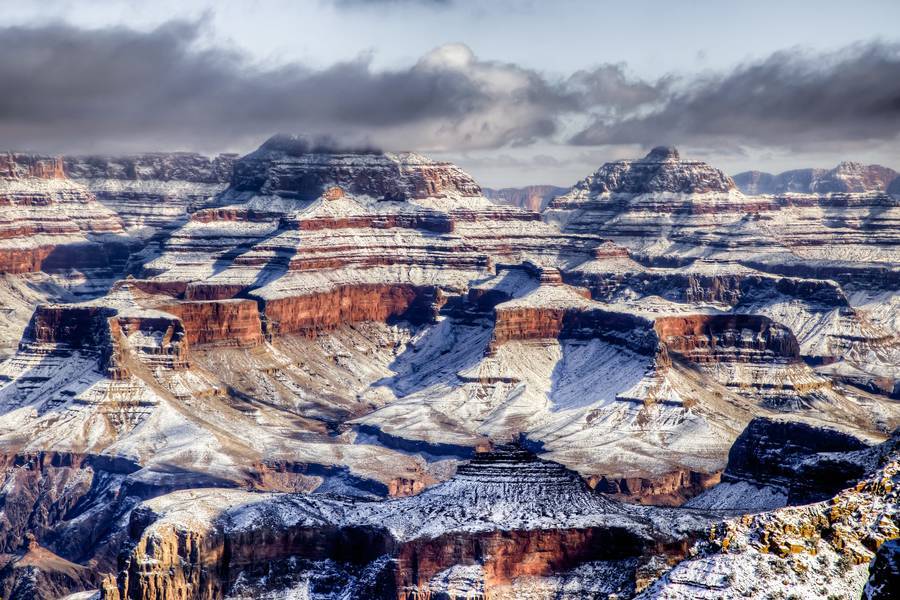
Average snowfall accumulation in the Grand Canyon during winter
Average winter temperature in the Grand Canyon
On the South Rim, the average temperatures range from 30°F to 45°F, creating a chilly yet manageable atmosphere for visitors. As you ascend to the higher elevations of the North Rim, temperatures can drop significantly, averaging between 20°F and 35°F. The West Rim shares a climate similar to the South Rim, with temperatures ranging from 30°F to 50°F during the winter months.
How to get around the Grand Canyon during the winter
You have two main options for getting around the Grand Canyon in the winter: using your own vehicle or taking advantage of the free shuttle buses.
Driving in the Grand Canyon in winter
Getting around the Grand Canyon in winter is a bit tricky, especially due to occasional snowstorms. They clean up the roads at the South Rim after heavy snowfall, but sometimes, they close temporarily for snow removal. If they’re calling for snow, maybe hold off on driving. If you find yourself in a surprise snowstorm, just take it super slow, especially if you can’t see much.
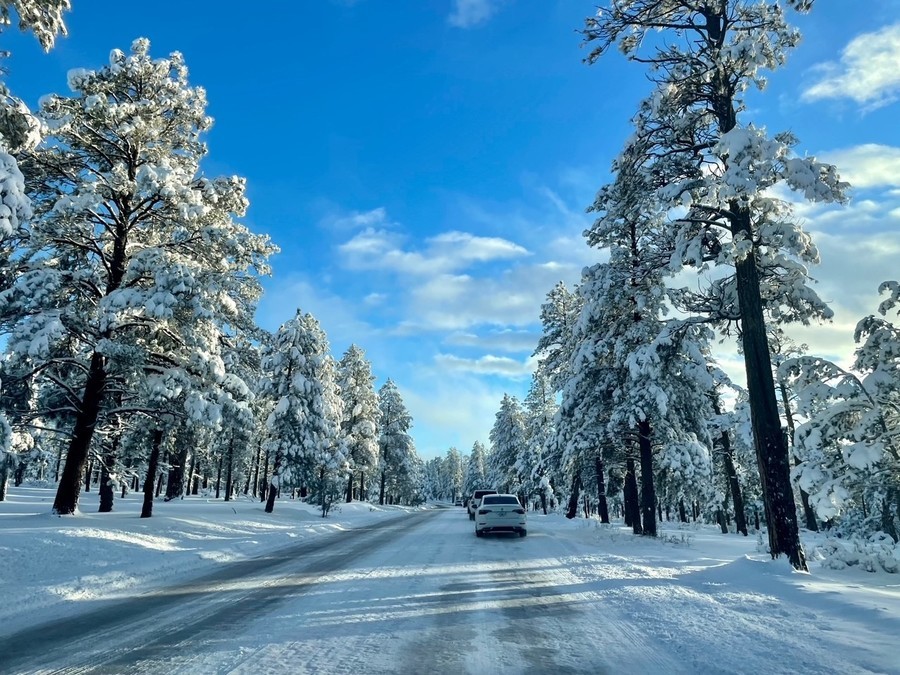
Driving in the Grand Canyon in winter
Keep in mind that between March 1 and November 30, the Hermits Rest Route is only accessible by shuttle bus. But if you’re at the Grand Canyon in December, January, or February, you can drive your own car and reach viewpoints along this route. In fact, this is a much better option if you prefer to explore each attraction at your own pace.
Grand Canyon shuttle bus during winter
For convenient transportation, I recommend taking advantage of the free shuttle service. The Grand Canyon South Rim provides four shuttle bus routes, two of which operate year-round: the Kaibab/Rim Route (orange), connecting the Visitor Center to the South Kaibab Trailhead, and the Village Route (blue), linking the Visitor Center Shuttle Bus Terminal with lodges, campgrounds, the Backcountry Information Center, and Market Plaza.
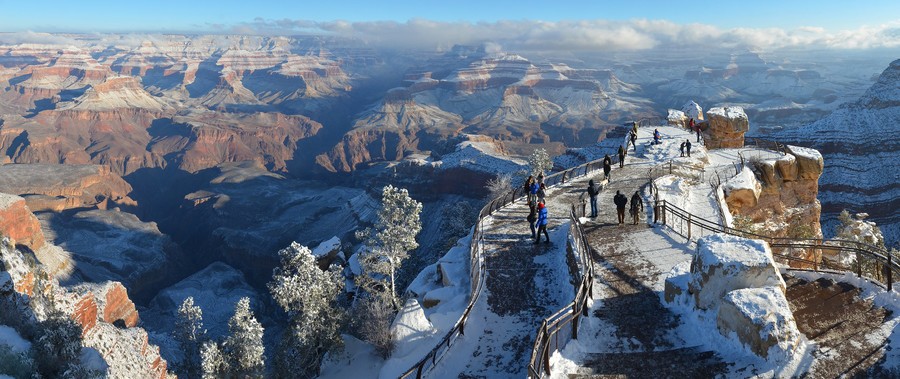
Grand Canyon shuttle bus during winter
Unfortunately, the remaining routes to Tusayan Village (purple) and the Hermits Rest Route (red) are not available during winter. The Hikers’ Express Shuttle also runs year-round, starting at the Bright Angel Lodge and traveling to the Backcountry Information Center, Visitor Center Shuttle Bus Terminal, and the South Kaibab Trailhead. You can check all the information about routes and schedules here.
Grand Canyon winter closures
While visiting the Grand Canyon during winter is a breathtaking experience, it’s crucial to be aware of seasonal closures. Starting in mid-October, visitor services, lodging, restaurants, and campgrounds at the North Rim shut down for the winter. Additionally, from December 1 to May 15, North Rim roads, including State Route 67, are off-limits to all vehicles, even snowmobiles. You will need to wait until mid-Spring to enjoy all the attractions at the Grand Canyon North Rim.
Pros and cons of traveling to the Grand Canyon in winter
Traveling to the Grand Canyon in winter offers a distinct experience with both advantages and drawbacks. Here’s a quick overview of the pros and cons of visiting the Grand Canyon during the winter season:
| PROS | CONS |
|
|
Is it worth visiting the Grand Canyon in winter?
Absolutely! Despite the winter chill, winter at the Grand Canyon offers a tranquil and enchanting experience. The reduced crowds and snowy landscapes create a serene atmosphere, allowing visitors to appreciate the beauty of this natural wonder in a more intimate setting. With unique opportunities for private exploration and a quieter ambiance, visiting the Grand Canyon during winter can be a rewarding and memorable adventure for those seeking a different perspective of this iconic destination.
Where to stay in the Grand Canyon in winter
Many travelers struggle with deciding where to stay in the Grand Canyon. Whether you’re seeking excitement or a laid-back retreat, there’s a diverse range of options to suit your preferences, budget, and travel style.
For a cozy stay, Yavapai Lodge stands out as one of the best hotels in the Grand Canyon South Rim. Conveniently located at the heart of the South Rim, this lodge offers well-appointed rooms and modern amenities, ensuring a comfortable and relaxing experience.
Maswik Lodge is located amidst the ponderosa pine forest and combines rustic charm with close proximity to the South Rim’s attractions, making it one of the best luxury hotels in the Grand Canyon. After exploring the canyon, you can unwind at the on-site bar or savor a delightful meal at the Maswik Food Court. The lodge is also pet-friendly, welcoming your furry companions.
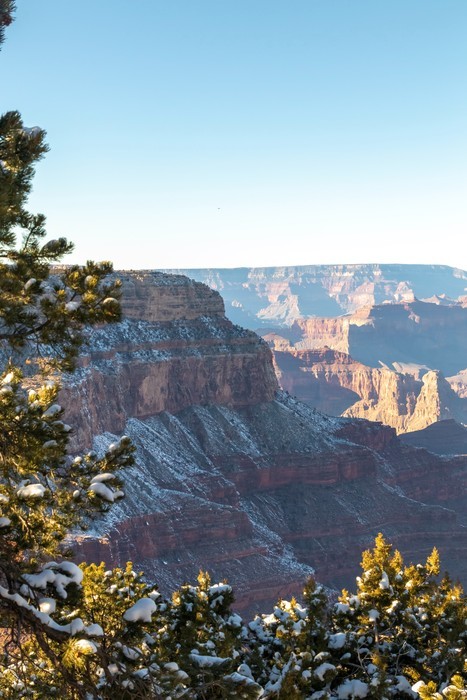
Where to stay in the Grand Canyon in winter
El Tovar Hotel is one of the best hotels in the Grand Canyon, located inside the park. This historic gem offers upscale accommodations and stunning views that immerse you in the canyon’s beauty. The hotel is very close to the Grand Canyon Village Historic District, Hopi House, and Mary Jane Colter buildings, making it an excellent choice for staying in the Grand Canyon during winter.
If, by any chance, accommodations within Grand Canyon National Park are fully booked, your second-best option is looking for one of the best hotels in Tusayan, the nearest town to the South Rim. Squire Resort at the Grand Canyon, for instance, is a great choice. With a range of room options, from the budget-friendly Queen Room to the more lavish Deluxe King Suite, this resort caters to diverse preferences.
Camping in the Grand Canyon
Camping in the Grand Canyon during winter is another challenging but exhilarating experience that might be worth considering. This is a rare opportunity to embrace the serenity of the winter landscape as the Grand Canyon takes on a different charm with its quieter ambiance and snow-dusted scenery. While tent camping can be quite challenging due to the cold temperatures, RV camping provides a cozy and comfortable option.
If you’re exploring the Grand Canyon by RV, both Mather Campground and Trailer Village RV Campground, both situated within Grand Canyon Village, remain open throughout the winter season.
Grand Canyon winter outfit ideas and other things to pack
One of the most important aspects of planning your trip is finding the right outfit for visiting the Grand Canyon in winter. The key is layering, ensuring you stay warm in the chilly temperatures. Start with a moisture-wicking base layer to keep you dry, add an insulating layer for warmth, and finish with a waterproof and windproof outer layer to protect against the elements. Don’t forget a hat, gloves, and a scarf for added warmth, along with sturdy and comfortable winter boots for traction on snowy trails.
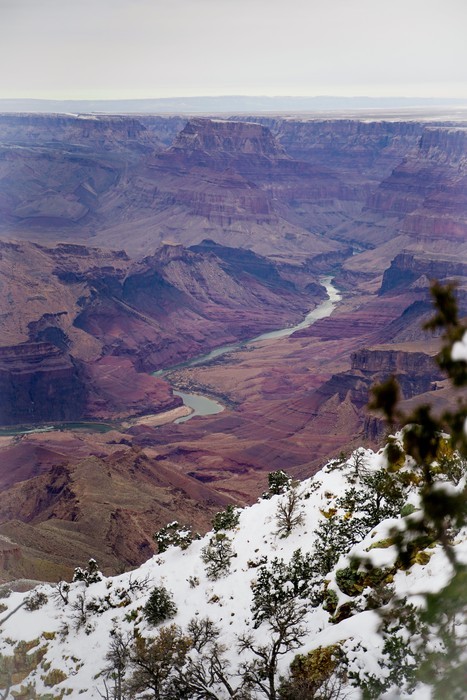
Grand Canyon winter outfit ideas and other things to pack
When assembling your Grand Canyon packing list, make sure to include a daypack stocked with water, snacks, and a thermos of warm beverages to keep you energized during the day. I also recommend getting a map or guidebook at the visitor center.
Other tips for visiting the Grand Canyon in winter
If you’re looking for a hassle-free experience, I suggest following these essential tips for visiting the Grand Canyon in winter:
- The key to a perfect Grand Canyon winter outfit is layering your clothing so you stay warm. This way, you’ll also be able to adapt to changing temperatures and weather conditions.
- Stay informed about trail and road closures due to ice or snow at the Grand Canyon. Plan activities accordingly to navigate the winter conditions effectively.
- Carry snacks and water, especially since services may be limited during the winter season. Remember that backpacking in the Grand Canyon in winter can be challenging, so ensure you have proper gear and are well-prepared for the colder conditions.
- I recommend joining winter programs led by park rangers to delve deeper into the park’s natural wonders. It’s an educational and enjoyable experience.
- To capture the beauty of the Grand Canyon in winter, make sure to bring your camera.
The Grand Canyon’s opening hours vary depending on the specific locations you decide to visit. The South Rim, including Grand Canyon Village, remains open year-round. However, facilities like the North Rim, Hermit Road shuttle, and some campgrounds close for the winter season. Make sure to check the park’s official website for detailed information on specific closures and opening hours during your winter visit.
FAQs – Grand Canyon in the winter
Now that you are fully equipped with all the information about visiting the Grand Canyon in winter, it’s time to answer some frequently asked questions.
And that concludes our guide on winter at the Grand Canyon. I hope this guide helps you plan your winter adventure, including where to go and what to do amidst the awe-inspiring winter landscape.
If you have other recommendations or questions about the best things to do in the Grand Canyon in winter, don’t hesitate to drop a comment below. I’d be happy to hear from you!
Safe travels!
